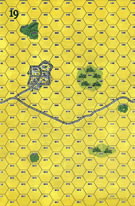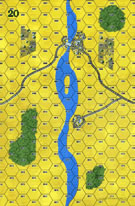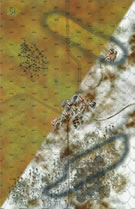|
And Poles We Shall Be Polish Steel #3 |
||
|---|---|---|
| (Attacker) Poland | vs | Soviet Union (Defender) |
| Formations Involved | ||
|---|---|---|
| Poland |  |
16th Armoured Brigade |
| Poland |  |
4th Infantry Division |
| Soviet Union |  |
260th Rifle Division |

| Total | |
|---|---|
| Side 1 | 0 |
| Draw | 1 |
| Side 2 | 0 |
| Overall Rating, 1 vote |
|---|
|
3
|
| Scenario Rank: --- of 913 |
| Parent Game | Polish Steel |
|---|---|
| Historicity | Alt-History |
| Date | 1948-07-03 |
| Start Time | 06:00 |
| Turn Count | 24 |
| Visibility | Day |
| Counters | 178 |
| Net Morale | 1 |
| Net Initiative | 3 |
| Maps | 4: 19, 20, 24, 3 |
| Layout Dimensions | 112 x 43 cm 44 x 17 in |
| Play Bounty | 208 |
| AAR Bounty | 171 |
| Total Plays | 1 |
| Total AARs | 1 |
| Battle Types |
|---|
| Rural Assault |
| Urban Assault |
| Paradrops |
| Conditions |
|---|
| Randomly-drawn Aircraft |
| Reinforcements |
| Terrain Mods |
| Scenario Requirements & Playability | |
|---|---|
| Cassino '44 | Counters |
| Eastern Front | Maps |
| Elsenborn Ridge | Maps |
| Polish Steel | Base Game |
| Road to Berlin | Counters |
| Introduction |
|---|
|
Hard ground fighting combined with liberal Allied air support won the Poles a victory at Oldenburg. Allied reinforcements streamed through the port of Wilhelmshaven and began massing for a major offensive against the Soviet northern flank. But the Allied Supreme Command detached Polish I Corps for a new mission: they were ordered to charge eastward across Northern Germany and into Poland, where the arrival of a Free Polish army would (supposedly) spark a massive popular revolt in the Soviet rear and thus force the Red Army to withdraw from western Germany. Eager to liberate their homeland, the Poles ignored the high risk and questionable reasoning behind this plan and moved out quickly. But before they could blaze a trail of freedom eastward, they would have to cross the Weser River. The Allies had gained air superiority over the northern reaches of the river but not as far south as Bremen, so the Poles would have to cross where it was widest. |
| Conclusion |
|---|
|
Polish paratroopers showed incredible valor at Arnhem in 1944, and the rebuilt brigade was considered a crack unit before its disbandment in 1947. Called back to the red-and-white banners, the paratroopers would be given the Polish corps a significant edge in vertical mobility. Perhaps enough of one to crack formidable river barriers like the Weser. |
| AFV Rules Pertaining to this Scenario's Order of Battle |
|---|
|
| 3 Errata Items | |
|---|---|
| Scen 3 |
The required aircraft counters were not included. See the AP website for downloadable replacements. (Shad
on 2010 Dec 01)
|

|
The reduced direct fire value in Kursk: Burning Tigers is 4-4. (plloyd1010
on 2015 Jul 31)
|

|
Kommissars never get morale or combat modifiers. Ignore misprints. (Shad
on 2010 Dec 15)
|
| Take a Ride on the 2:12 |
|---|
|
Despite the fact that this one ended as a draw it is highly weighted towards a Polish victory. The time indicated in the title of the AAR is reflective of the rolls of the Soviets artillery during the first 6 turns. The losses and disruption this caused the Poles led to a slow development of their offensive and the inability of the Poles to clear the last step of Soviets from the last objective, despite rolling ont he 24 column for assault and the morale of 6. Around turn 10 I actually had some doubts as to the Poles ability to do the job at all. They were slowly moving across the bridge but their secondary crossings in the center and far right of the line were not getting any traction. At that point the Polish artillery and mortars began rolling like Soviets and the far left of teh Soviet line evaporated. Since the Soviets had already reached their minor victory condition of 20 Polish losses the Poles could be a bit more daring and pushed hard to reach their major victory conditions. Starting at turn 16, the Soviets began running away and really didn't stop appreciably through the rest of the game. An interesting sidelight to the game was the Polish airdrop. These troops were almost without effect until the very end of the scenario when they were the primary infantry component of the assault on the town on board 19. Indeed the JSU-122s ran through some of the paratroopers until a Black Prince platoon shook loose and left a bunch of burning hulks. In the final analysis, the tremendous fire results for the Soviets in the early part of the game resulted in their ability to hang on by their fingernails for a draw. Without those it seems certain that the Poles would have captured a major victory but in the end result here it was only two minor victories matched up. In general I would expect the Soviets to reach a minor victory anyway due to their ability to have some serious firepower in their assault hexes and they do have a bunch of artillery. Due to the likely results I can only give this a "3". It just doesn't seem to have enough variability to earn anything higher. |
| 0 Comments |

 PoSt002
PoSt002 









































